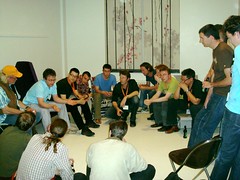Last week I had an interesting 4-day consulting gig for a client in Boulder. I was supposed to fly out to Connecticut to deliver a training course, but it got rescheduled due to the 45-day Vendor Approval Process I need to go through. The client in Boulder wanted me to come out and do an architectural assessment and provide recommendations. Topics they were interested in: web tier (specifically Spring MVC), Security, Ajax integration, build process, web services and localization. I've done this kind of before with Virtuas, but this time was different. With Virtuas, I'd do 5-days worth of presentations on just about anything the customer wanted. For example, checkout this agenda for a client in NY last year.
With the company in Boulder, I delivered zero presentations. Instead, everything we talked about and coded was hands-on. On Tuesday, we started out by discussing their application and some issues they were having. They'd done a lot of customization to Spring MVC and had managed to eliminate all the XML needed when adding new controllers and views. I spent 3-4 hours that day with 2 of their engineers finalizing and implementing their convention-over-configuration rules. On Wednesday, I helped them implement Acegi Security into their application. This was interesting because they didn't have any security mechanism and we had to implement Acegi from scratch and then tie it into their backend (using a custom AuthenticationProvider). We also integrated i18n so all messages were retrieved from their database.
On Thursday, we configured Ant to run their tests and wrote some tests for their controllers. As part of this process, I showed them how to use jMock and EasyMock and tried to explain the benefits of using Spring IoC (which they still aren't sold on). On Friday, we integrated Selenium into their build process and wrote a few tests using Selenium's Java support. In the afternoon, I showed them how they might use Scriptaculous and Prototype to Ajax-enable some features in their application.
Doing all the "live coding" on someone else's machine (with 5 developer's watching) was a bit nerve wracking. However, thanks to Cenqua's FishEye tool, I was able to search AppFuse and AppFuse Light's SVN repositories for code snippets and examples. While I knew how to do much of the stuff we covered, FishEye and Google bailed me out when I didn't. About halfway through, I realized that I don't keep a lot of my knowledge in my head. Instead, it's on this blog, or spread out on the web. I don't remember URLs anymore, all I remember are keywords. If I've read a blog post or article on the web, chances are I can find it again pretty easily with Google. Even though I store a lot of bookmarks in del.icio.us, I didn't use it all week. Remembering keywords is the new bookmark for me.
The whole week was an interesting exercise in "live coding." The whole team (6 or so) sat in a conference room all week and VNC'ed into the architect's box to do the work. We worked in Eclipse and used WTP to deploy/test things on Tomcat. The keyboard was passed around between developers at random and everyone got a chance to implement new features. I think the reason that everything worked so well was because the team was full of Senior Java Developers. Everyone learned from each other as they saw new shortcuts, keystrokes and ways or writing code. I don't know if this kind of thing will work in all development teams, but I'd encourage you to try it. It's a great way to share knowledge and educate the entire team on how a new module works.
Over the weekend, I received the following e-mail from one of the developers on the team:
Very nice to meet you this past week and get a chance to see firsthand the breadth and depth of your experience in web app frameworks and such. I believe due to your visit, we will be cranking happily along here very shortly. Everyone was quite happy with the results at the end of the day yesterday.
On a related note, if you're looking to hire an enthusiastic Web + Java Developer, please take a look at my resume or send me an e-mail. My current contract ends this month and I'm hoping to find something new to get me through the summer.
Spotted on the Acegi Security mailing list several weeks ago:
A few weeks ago, I started an open source project (Security Annotation Framework) which addresses annotation-based, instance-level access control for Spring applications. It is also based on Spring 2.0's extensible XML authoring features. You can find more info at
http://sourceforge.net/projects/safr and http://safr.sourceforge.net
The framework was created during a project in 2006 and is now available under the Apache 2.0 license. It's a generic framework focused on processing security annotations on Spring beans as well as domain objects (which typically aren't managed by a Spring application context) and can be used to enforce access decisions for domain object instances. It can be used with any authorization provider and is not specific to Acegi. However, I plan to include an example how to use the SAF with Acegi authorization soon. Furthermore, it supports inheritance of annotations from base classes and interfaces.
What do you think about SAF? Are annotations a better way of implementing ACLs on domain objects?
Here's a couple of good blog entries I've enjoyed reading over the past few days - in case you missed them:
Warner is spot on when it comes to Tapestry's biggest problem. Let's hope Tapestry 5 is the end-all-be-all that Howard thinks it will be. As for Gavin's post, I like it because it's mostly true and the f-bomb makes it enjoyable to read. ;-)




